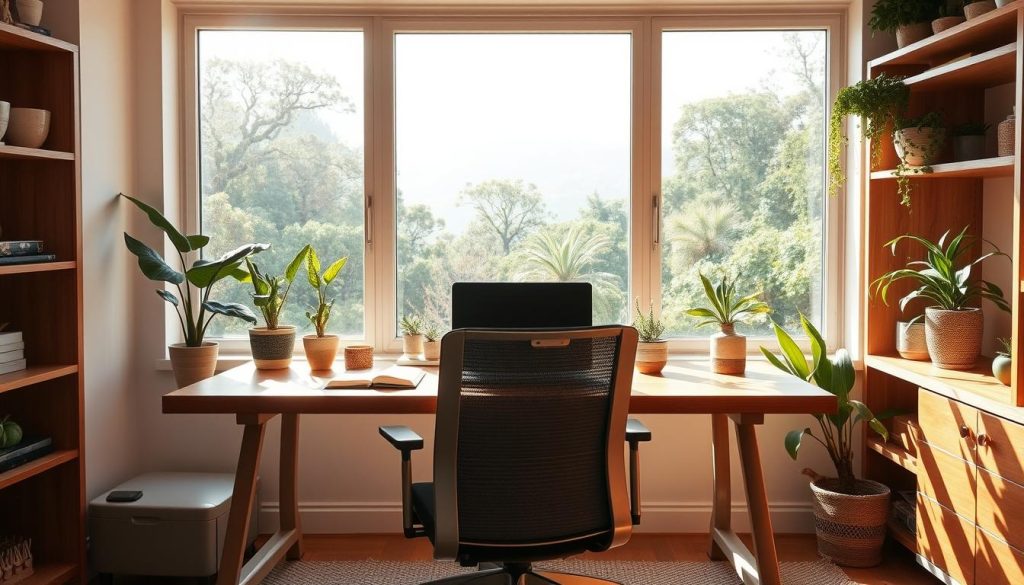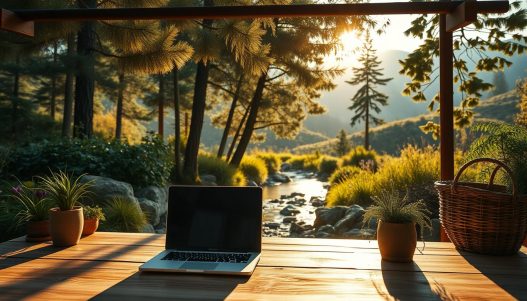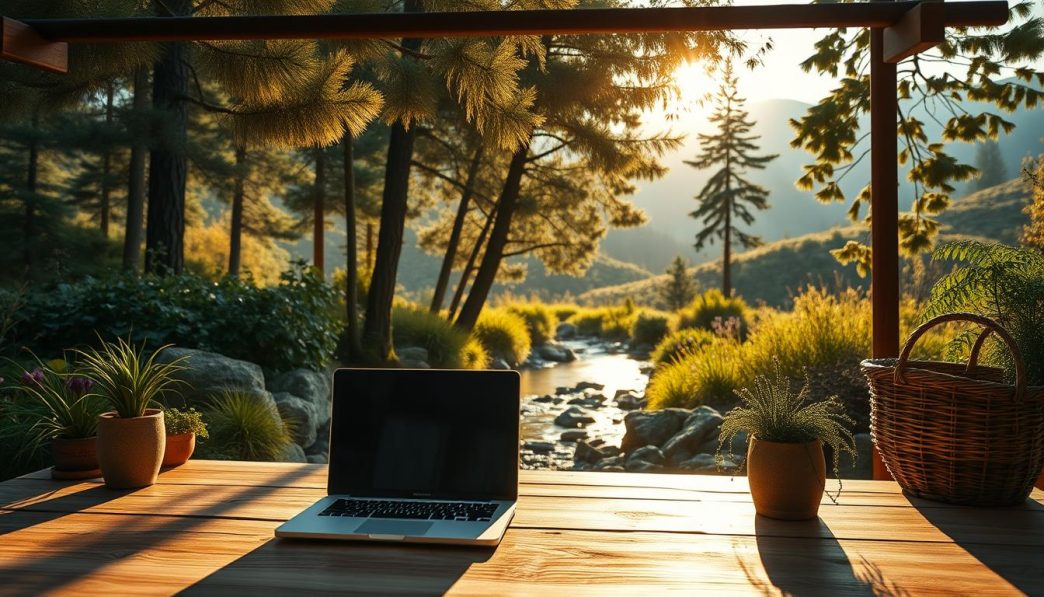Imagine starting your workday with ocean views instead of office walls. Over 40% of American professionals now operate outside traditional offices, blending career ambitions with personal fulfillment. This shift creates exciting opportunities to rethink how we approach daily routines.
Recent studies reveal a surprising contradiction: while flexible arrangements boost business output, nearly half of teleworkers report declining mental health. This paradox sparks demand for innovative solutions that address both professional performance and self-care needs.
The emerging trend of extended stays in inspiring locations offers fresh answers. By strategically choosing environments that nourish body and mind, professionals report improved focus and reduced stress levels. Employers increasingly recognize these benefits, with forward-thinking companies seeing 27% lower turnover rates among staff using blended travel-work approaches.
Key Takeaways
- 41% of U.S. professionals now work outside traditional offices
- 45% experience mental health challenges when working remotely
- Destination-based work models increase job satisfaction
- Effective workspace design boosts output by 18-22%
- Companies using travel-work programs retain talent longer
This guide explores practical methods for creating fulfilling routines that honor both career ambitions and personal needs. From tech setups that maintain productivity to location choices that spark creativity, we’ll help you craft experiences that elevate all aspects of your life.
Introduction to the World of Wellness Workations
Modern professionals are redefining productivity by blending deadlines with destinations. Instead of choosing between career growth and self-care, many now merge both through strategic location shifts. This approach helps combat burnout while keeping projects on track.
Defining Workations and Their Growing Popularity
A workation lets you maintain job responsibilities while exploring new environments. Over 60% of U.S. companies now permit temporary location changes for staff. This flexibility stems from improved tech tools and shifting attitudes about workplace effectiveness.
Understanding the Blend of Work and Health Travel
The best trips combine focused task time with energizing activities. Morning yoga sessions might precede client calls, while afternoon hikes replace stressful commutes. These intentional combinations help professionals:
- Refresh their minds through nature immersion
- Maintain fitness routines while traveling
- Discover creative inspiration from new surroundings
Successful planners often alternate work blocks with local cultural experiences. A 2023 survey found 78% of hybrid workers reported better focus after location changes. The key lies in balancing screen time with soul-nourishing adventures.
Understanding the Remote Work Revolution in the United States
Nearly half of American professionals now log in from kitchens instead of cubicles. This seismic shift in where we complete tasks has rewritten office culture rules. Let’s explore how this transformation affects both daily routines and long-term career satisfaction.

Current Remote Work Statistics and Trends
Recent data shows 41% of U.S. staff operate outside traditional offices for part or all of their week. What began as pandemic necessity has become permanent for many companies. Tech advancements now let teams collaborate across time zones as easily as across desks.
The change goes deeper than location flexibility. Workers report valuing control over their schedules as much as saved commute time. A TELUS International study reveals 80% feel pressured to stay constantly available online. This “always-on” mentality creates new challenges for maintaining healthy boundaries.
Impact on Work Environment and Employee Well-Being
While remote setups offer freedom, 45% of professionals say home-based roles affect their mental health. Common struggles include:
- Difficulty separating job tasks from personal time
- Reduced face-to-face social interactions
- Inconsistent access to ergonomic equipment
Forward-thinking companies are redesigning support systems. Some offer stipends for coworking spaces, while others host virtual team-building activities. These adaptations help combat isolation without sacrificing location independence.
The revolution continues evolving as businesses and staff refine hybrid models. Success now depends on balancing flexibility with human-centered policies that protect well-being. As one HR director notes: “Our greatest challenge isn’t tracking hours – it’s ensuring people feel connected while apart.”
Benefits of Integrating Work and Wellness Travel
Changing your environment while maintaining professional commitments unlocks surprising advantages. Professionals discover renewed energy when swapping familiar settings for inspiring locations that prioritize both task completion and self-care.
Boosting Productivity and Enhancing Mental Health
New surroundings act like a mental reset button. Without office chatter or household chores, 72% of professionals report completing tasks faster during blended trips. One marketing director noted: “I finished a month’s worth of reports in 10 days near Lake Tahoe.”
Creative breakthroughs often follow exposure to different cultures. A Stanford study found workers solve complex problems 19% faster after environment changes. Morning meditation sessions or midday nature walks further sharpen focus while reducing stress hormones.
Achieving a Strong Work-Life Balance
Intentional scheduling makes career and personal goals coexist peacefully. Many successful travelers alternate client calls with:
- Sunrise yoga sessions
- Local cultural explorations
- Rejuvenating outdoor adventures
This rhythm prevents burnout better than traditional vacations. A 2023 survey showed 68% of blended travelers maintained exercise routines compared to 42% of office workers. As one software developer put it: “I return feeling accomplished professionally and renewed personally.”
Creating the Ideal Workation Environment
Your laptop screen reflects palm trees instead of cubicle walls – proof that great work happens anywhere. The secret lies in crafting spaces that fuel both concentration and inspiration. Let’s explore how to build professional setups that adapt to your surroundings.

Setting Up a Productive Workspace Anywhere
Forget the myth that quality work requires a corporate office. A functional environment starts with three essentials: reliable tech, ergonomic support, and intentional design. Portable monitors and compact keyboards let you recreate office efficiency in beachside bungalows or mountain cabins.
Choose your home base wisely. Look for accommodations offering dedicated work areas with strong Wi-Fi. Position your setup near natural light sources – studies show this boosts energy levels by 15%. Keep a foldable laptop stand in your bag to maintain proper posture wherever you land.
Minimizing Distractions and Establishing Boundaries
New environments bring exciting distractions. Combat this by creating clear physical divisions between work zones and leisure spaces. Use room dividers or strategic furniture placement if your rental lacks separate areas. Noise-canceling headphones become your best ally in bustling locations.
Set non-negotiable work hours and communicate them to travel companions. A 2023 FlexJobs survey found professionals who block specific task times complete projects 23% faster during blended trips. Turn off non-essential notifications and use app blockers during deep work sessions.
Remember: Your ideal environment balances professional needs with personal renewal. As digital nomad Mia Chen notes: “My productivity skyrocketed when I stopped trying to replicate corporate offices and started designing spaces that spark joy.”
Health and Wellness Strategies for Remote Workers
Your desk could be steps from a hiking trail instead of a coffee machine. Many professionals struggle to stay active when working outside traditional offices – one study found remote employees average just 16 steps between bed and workspace. Addressing these challenges requires creative solutions that blend location advantages with smart health practices.
Movement Matters: Active Solutions for Stationary Lifestyles
Swap screen time for stair climbs or lunchtime swims. Destinations with built-in activity options make exercise effortless. “I schedule client calls after morning surf sessions,” shares Colorado-based developer Mark T. “The energy boost helps me tackle complex code faster.”
Mental health tools prove equally vital. Apps offering meditation guides or virtual therapy sessions help manage stress during location transitions. Employers increasingly cover these through flexible stipends – 68% of staff report better focus when using employer-funded wellness apps.
Financial Support for Holistic Well-Being
Forward-thinking companies now offer monthly allowances for health-related expenses. These funds might cover:
- Portable fitness equipment like resistance bands
- Subscription-based mental health platforms
- Local adventure tours during non-work hours
Personalized benefits like HRAs let teams choose care options matching their needs. A 2022 survey showed 89% of professionals prioritize employers offering robust health packages. As benefits manager Lisa Chen notes: “Tailored support builds loyalty while keeping teams energized.”
Planning Your Workation Itinerary for Success
Picture your ideal weekday: morning sunlight streaming through new windows as you tackle tasks, followed by afternoon adventures in uncharted terrain. The secret to making this vision reality lies in thoughtful preparation that respects both job demands and exploration cravings.
Structuring Days for Maximum Impact
Design your schedule like a local guidebook – packed with must-see stops but flexible enough for detours. Start by blocking non-negotiable work hours first, then layer in leisure activities. Early risers might reserve mornings for deep focus, freeing afternoons for hiking trails or cultural tours.
Test different time management approaches before departure. Some professionals thrive with four concentrated workdays followed by three-day weekend escapes. Others prefer daily splits – mornings for emails, evenings for sunset kayaking. Consistency matters more than the specific schedule type you choose.
Build buffer periods into every plan. That mountain town Wi-Fi outage? Your backup mobile hotspot saves the day. Unexpected festival in your temporary neighborhood? Shift tasks to tomorrow’s open slot. Successful itineraries balance structure with spontaneity, letting you excel professionally while soaking up fresh experiences.






